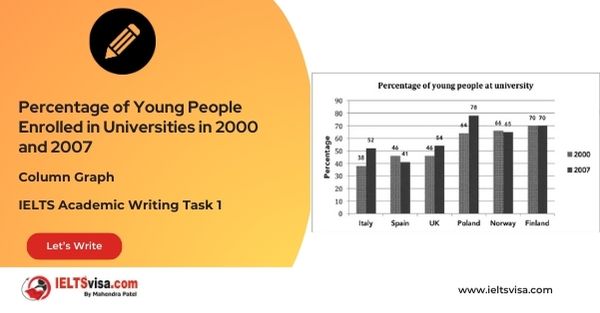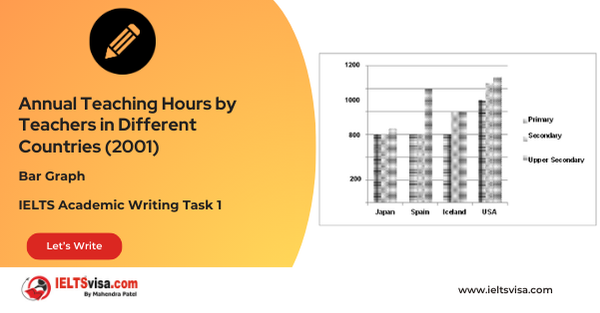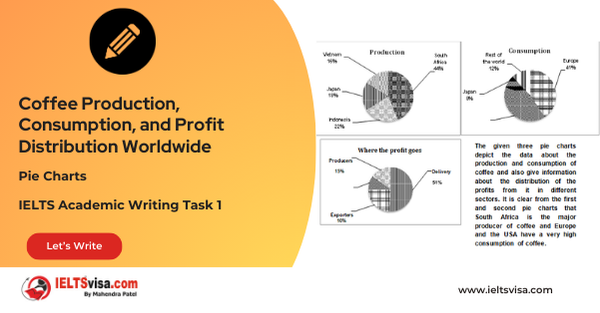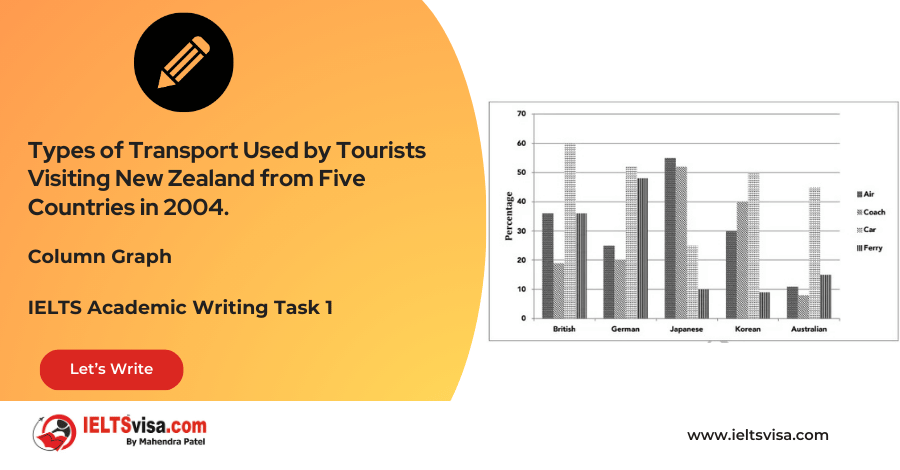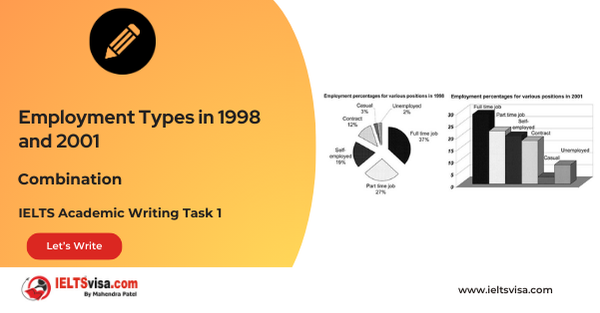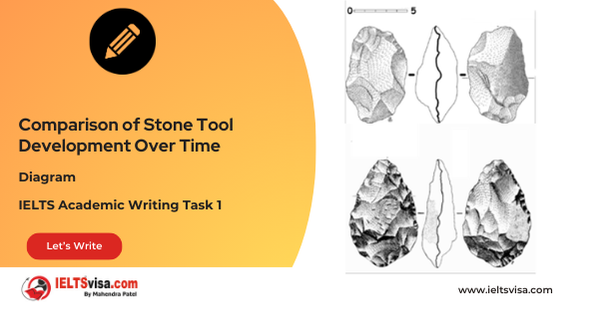Cinema Attendance on Different Days of the Week (2003, 2005, 2007)
IELTS Academic Writing Task 1 - Bar Graph
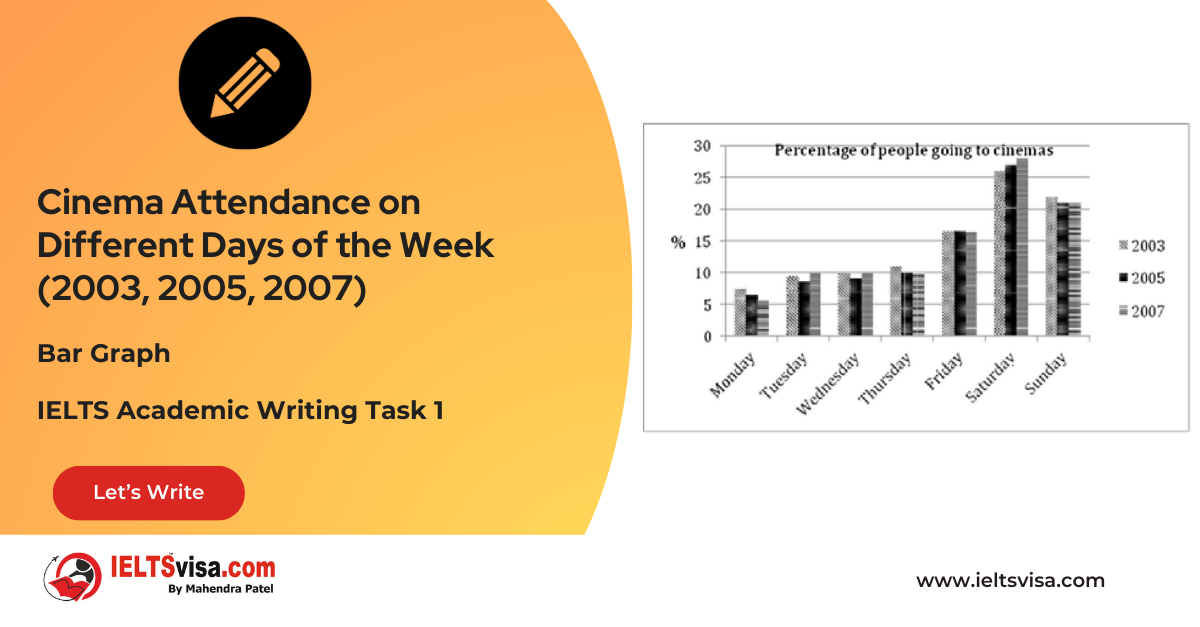
IELTS Writing Task 1 Question
The graph below shows the cinema attendance of people on different days of the week in 2003, 2005 and 2007. Summarise the information by selecting and reporting the main features and make comparison where relevant.
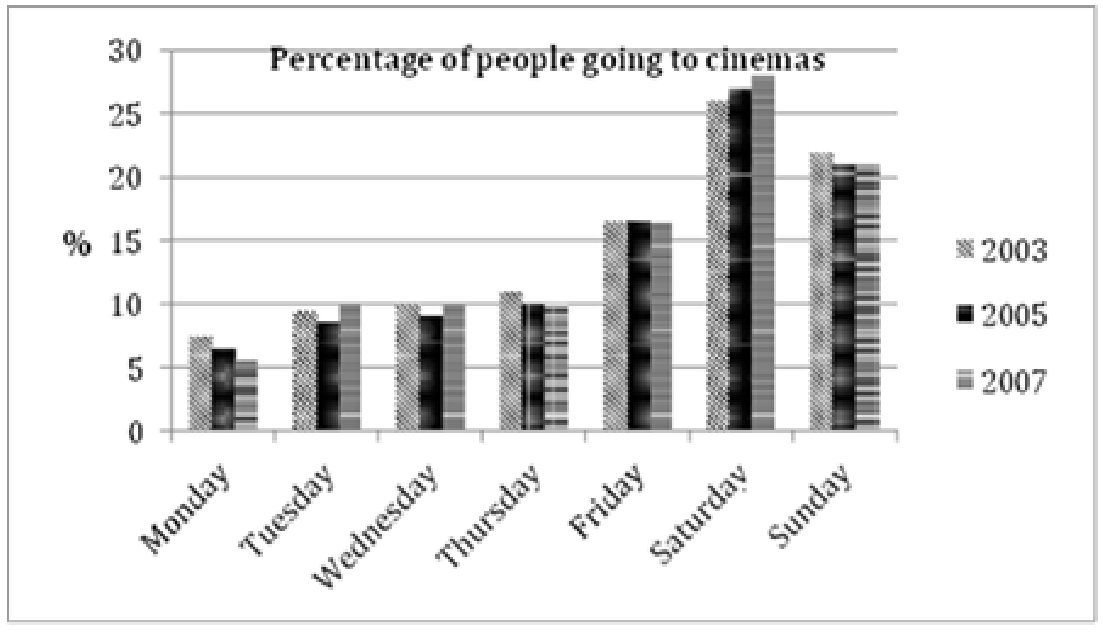
Key Points for the Report
1. Graph Type: Bar Graph
2. Title: Cinema Attendance on Different Days of the Week (2003, 2005, 2007)
3. Focus: Percentage of people attending cinemas across various days over three years
Main Features and Trends
General Observations
- Peak Attendance: Cinema attendance was significantly higher on weekends compared to weekdays.
- Consistency Over Years: The overall patterns in attendance remained relatively stable across the three years.
Sample Answer
The graph illustrates the percentage of people attending cinemas on different days of the week for 2003, 2005, and 2007.
Overall, it is clear from the graph that attendance was higher on weekends than on weekdays.
Throughout the three years, there was minimal variation in cinema attendance. From Tuesday to Thursday, about 10% of people went to the cinemas in all three years. Mondays had the lowest attendance, with percentages declining from 7.5% in 2003 to 5% in 2007. In contrast, attendance on Fridays remained relatively stable, with a little over 15% of people attending.
On weekends, cinema attendance peaked, with over 25% of people going on Saturdays and around 20% on Sundays. Overall, attendance on Saturdays showed a slight increase over the years, while attendance on Mondays decreased gradually.
Top 27 Vocabularies
| Vocabulary | Meaning | Synonyms | Examples | Verb Types |
|---|---|---|---|---|
| Depicts | To represent or show something through art or data | Illustrates, portrays, represents | The graph depicts cinema attendance over three years. | Verb |
| Attendance | The act of going to a place, often measured in numbers | Presence, participation, turnout | Attendance was higher on weekends than on weekdays. | Noun |
| Variation | A change or difference in condition, amount, or level | Difference, fluctuation, diversity | There was minimal variation in attendance across the years. | Noun |
| Percentage | A rate, number, or amount in each hundred | Proportion, fraction, part | About 10% of people attended the cinemas on weekdays. | Noun |
| Declining | Becoming smaller, fewer, or less | Decreasing, diminishing, reducing | The percentage of attendees on Mondays was declining. | Verb |
| Illustrates | To explain or clarify using visuals or examples | Depicts, explains, demonstrates | The graph illustrates the percentage of cinema attendance. | Verb |
| Minimal | Very small in amount | Negligible, slight, insignificant | There was minimal variation in attendance. | Adjective |
| Stable | Not changing frequently | Steady, consistent, constant | Attendance on Fridays remained relatively stable. | Adjective |
| Peaked | Reached the highest point | Climaxed, reached a maximum | Cinema attendance peaked on Saturdays. | Verb |
| Gradually | Slowly or steadily over time | Slowly, progressively, step by step | Attendance on Mondays decreased gradually. | Adverb |
| Contrast | The state of being strikingly different | Difference, disparity, distinction | There is a contrast between weekday and weekend attendance. | Noun |
| Consistent | Remaining steady and unchanging | Regular, stable, uniform | Cinema attendance was consistent on weekdays. | Adjective |
| Notable | Worthy of attention or importance | Remarkable, significant, noteworthy | Saturday showed a notable increase in attendance. | Adjective |
| Significant | Sufficiently great or important | Important, notable, considerable | There was a significant difference between weekday and weekend attendance. | Adjective |
| Fluctuation | An irregular rising and falling in number or amount | Variation, oscillation, change | There was little fluctuation in weekday attendance. | Noun |
| Proportion | A part or share of a whole | Fraction, percentage, ratio | A large proportion of people attended on weekends. | Noun |
| Trend | A general direction in which something is developing | Pattern, tendency, movement | The trend shows higher weekend cinema attendance. | Noun |
| Weekday | Any day of the week except Saturday or Sunday | Workday | Attendance was lower on weekdays compared to weekends. | Noun |
| Relatively | In relation or proportion to something else | Comparatively, moderately | Fridays showed relatively stable attendance. | Adverb |
| Evident | Clearly seen or understood | Apparent, obvious, clear | It is evident that weekends had higher attendance. | Adjective |
| Decline | A gradual decrease or reduction | Drop, fall, reduction | There was a decline in attendance on weekdays. | Noun |
| Increase | A rise in number, amount, or level | Growth, rise, escalation | Saturday showed a slight increase in attendance. | Noun |
| Reachable | Able to be accessed or achieved | Accessible, attainable | Weekend cinemas were more reachable for most people. | Adjective |
| Moderate | Average in amount, intensity, or degree | Reasonable, medium, mild | The change in attendance was moderate over the years. | Adjective |
| Weekend | The days of Saturday and Sunday | — | Attendance peaked during the weekend. | Noun |
| Participation | The action of taking part in an activity | Involvement, engagement | Participation was higher on Saturdays than weekdays. | Noun |

Our Books
Master IELTS Speaking Part 1
IELTS Writing Task 1 Book
IELTS Writing Task 2 Book
Writing Task 1 Question Types
Practice IELTS Other Modules
IELTS Listening
The IELTS Listening test assesses how well you can understand spoken English in various contexts. It lasts about 30 minutes and is divided into four sections with a total of 40 questions. The listening tasks become increasingly difficult as the test progresses.
IELTS Academic Reading
The IELTS Academic Reading section assesses your ability to understand and interpret a variety of texts in academic settings. It is designed to evaluate a range of reading skills, including skimming for gist, reading for main ideas, reading for detail, understanding inferences, and recognizing a writer's opinions and arguments.
IELTS Speaking
The IELTS Speaking test assesses your ability to communicate in English on everyday topics. It lasts 11-14 minutes and consists of three parts: introduction, cue card, and a discussion based on the cue card topic.
IELTS General Reading
IELTS General Reading tests your ability to understand and interpret various types of texts. Here are some key areas and types of content you can expect to encounter in the reading section, along with tips for effective preparation.
IELTS Academic Writing Task 1
In IELTS Academic Writing Task 1, you are presented with a visual representation of information, such as graphs, charts, tables, or diagrams, and you are required to summarize, compare, or explain the data in your own words.
IELTS General Writing Task 1
In IELTS General Writing Task 1, you are required to write a letter based on a given situation. The letter can be formal, semi-formal, or informal, depending on the prompt. Here’s a breakdown of the key components to include in your letter
IELTS Academic Writing Task 2
In IELTS Academic Writing Task 2, you are required to write an essay in response to a question or topic. Here’s a guide to help you understand the essential elements of this task
IELTS Exam Tips
To succeed in the IELTS exam, practice regularly, familiarize yourself with the test format, improve your vocabulary, develop time management skills, and take mock tests to build confidence.
Grammer for IELTS
Grammar is the foundation of effective communication in English. Understanding tense usage, subject-verb agreement, and sentence structure enhances clarity and coherence in writing and speaking.
Vocabulary for IELTS
Vocabulary plays a crucial role in the IELTS (International English Language Testing System) exam, especially in the Speaking and Writing sections. Here’s an overview of why vocabulary is important and how it impacts your performance
RECENT IELTS SAMPLES QUESTIONS AND ANSWERS
Task 1 – Column graph – Percentage of Young People Enrolled in Universities in 2000 and 2007.
20:00 Start Pause Stop [df_adh_heading title_infix="IELTS Writing Task 1 Question" use_divider="on"...
Task 1 – Bar Graph – Annual Teaching Hours by Teachers in Different Countries (2001)
20:00 Start Pause Stop [df_adh_heading title_infix="IELTS Writing Task 1 Question" use_divider="on"...
Task 1 – Pie Charts – Coffee Production, Consumption, and Profit Distribution Worldwide
20:00 Start Pause Stop [df_adh_heading title_infix="IELTS Writing Task 1 Question" use_divider="on"...
Task 1 – Column graph – Types of Transport Used by Tourists Visiting New Zealand from Five Countries in 2004.
20:00 Start Pause Stop [df_adh_heading title_infix="IELTS Writing Task 1 Question" use_divider="on"...
Task 1 – Bar and Pie Chart Combination – Employment Types in 1998 and 2001
20:00 Start Pause Stop [df_adh_heading title_infix="IELTS Writing Task 1 Question" use_divider="on"...
Task 1 – Diagram – Comparison of Stone Tool Development Over Time
20:00 Start Pause Stop [df_adh_heading title_infix="IELTS Writing Task 1 Question" use_divider="on"...

